Göring, Edda Carin Wilhelmine, born 02-06-1938 in Berlin Germany,  the only child of Nazi leader Hermann Wilhelm Göring and his second wife, the actress Emmy Johanna Henny, Göring, born Sonneman. Göring’s first wife was Carin Axelina Hulda Fock
the only child of Nazi leader Hermann Wilhelm Göring and his second wife, the actress Emmy Johanna Henny, Göring, born Sonneman. Göring’s first wife was Carin Axelina Hulda Fock  she died 17-10-1931, of a heart attack, age 42, in Stockholm. Göring married Carin Fock on 10-04-1935.
she died 17-10-1931, of a heart attack, age 42, in Stockholm. Göring married Carin Fock on 10-04-1935.
Edda’s birth, with as godfather Adolf Hitler, was remarkable, 
 as her mother was already 45 and Hermann Göring had suffered a gunshot wound to the groin during the Beer Hall Putsch.
as her mother was already 45 and Hermann Göring had suffered a gunshot wound to the groin during the Beer Hall Putsch. 
 Der Spiegel wrote of an immaculate conception. In 1940, Julius “Frankenführer” Streicher
Der Spiegel wrote of an immaculate conception. In 1940, Julius “Frankenführer” Streicher

 wrote in Der Stürmer that Edda had been conceived by artificial insemination. Hermann Göring asked the Third Reich Lawyer, Party Reichsleiter and also SS-Obergruppenführer Walter Buch
wrote in Der Stürmer that Edda had been conceived by artificial insemination. Hermann Göring asked the Third Reich Lawyer, Party Reichsleiter and also SS-Obergruppenführer Walter Buch 
 to take action, but Hitler intervenedq and Streicher was allowed to continue publishing Der Stürmer
to take action, but Hitler intervenedq and Streicher was allowed to continue publishing Der Stürmer 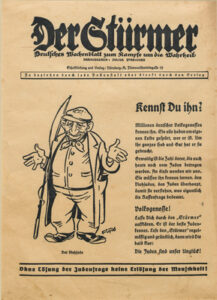 from his place of exile near Nuremberg. When Göring came to collect his wife and daughter ten days after the birth, cheering crowds lined the streets. Göring received 628,000 messages of congratulations, including telegrams from E. F. L. Wood, 1st Earl of Halifax
from his place of exile near Nuremberg. When Göring came to collect his wife and daughter ten days after the birth, cheering crowds lined the streets. Göring received 628,000 messages of congratulations, including telegrams from E. F. L. Wood, 1st Earl of Halifax  and Charles Vane-Tempest-Stewart, 7th Marquess of Londonderry.
and Charles Vane-Tempest-Stewart, 7th Marquess of Londonderry.  Edda Göring was baptised at Carinhall on 4 November 1938, her godfather was Adolf Hitler, and Life magazine reported.
Edda Göring was baptised at Carinhall on 4 November 1938, her godfather was Adolf Hitler, and Life magazine reported.
She grew up at Carinhall as a little princess. She was called the Little Prinzessin, “Nazi crown princess” according to a Time journalist, and Adolf Hitler was her godfather. Edda was much loved by the Nazi top brass, and received many extravagant gifts from her father, including expensive works of art and miniature versions of Prussian palaces. The Luftwaffe built in an orchard at Carinhall the Edda-Schlösschen, a small version of Frederick the Great’s Sanssouci Palace, 50 m long, 7 m wide and 3.5 m high with its own theater inside.
Toward the end of World War II, Hermann Göring moved with his family to his residence at Obersalzberg near Berchtesgaden. 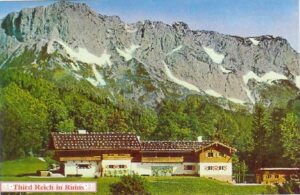 On 21-5-1945, Edda was interned with her parents in the American Camp Ashcan at Mondorf-les-Bains.
On 21-5-1945, Edda was interned with her parents in the American Camp Ashcan at Mondorf-les-Bains.  In 1946, Emmy and Edda were free
In 1946, Emmy and Edda were free  and lived in Burg Veldenstein at Neuhaus an der Pegnitz near Nuremberg. Edda visited her father in prison during the Nuremberg Trials.
and lived in Burg Veldenstein at Neuhaus an der Pegnitz near Nuremberg. Edda visited her father in prison during the Nuremberg Trials.
After the war, Edda Göring was a regular guest of Wagner-Williams, Winifred Majorie “Winnichen” 
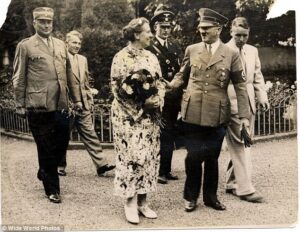 in Bayreuth. In 1948, Edda Göring entered the Oberrealschule in Sulzbach-Rosenberg while the family lived near Hersbruck. At the end of November, Edda moved with her mother to Etzelwang.
in Bayreuth. In 1948, Edda Göring entered the Oberrealschule in Sulzbach-Rosenberg while the family lived near Hersbruck. At the end of November, Edda moved with her mother to Etzelwang. 
Death and burial ground of Edda Göring.




In 1949, Emmy Göring filed lawsuits and she was arrested, stating, that several valuable items were Edda’s property. Edda worked as a clerk in a law firm and studied law at the University of Munich. In 1954, Edda forced the state of Bavaria to return her confiscated jewelry worth 150,000 German marks. In 1959 she lived with her mother in a small apartment on the fifth floor of a modern residential block in the Altstadt-Lehel district of central Munich. She worked in a hospital laboratory and wanted to become a technical-medical assistant. Edda never married and took care of her mother until she died on 21-12-2018, age 80 in München,. In the 1970s the Stern journalist Gerd Heidemann bought the yacht Carin II that had belonged to Hermann Göring. Edda became Heidemann’s life companion for five years. On the ship they received, among others, Generals Karl Wolff 
 and Wilhelm Heinrich Johannes Mohnke.
and Wilhelm Heinrich Johannes Mohnke. 
 She worked in a rehab clinic in Wiesbaden. In 1991, in an interview with Gerald Posner, she said of her father:
She worked in a rehab clinic in Wiesbaden. In 1991, in an interview with Gerald Posner, she said of her father:
I loved him very much 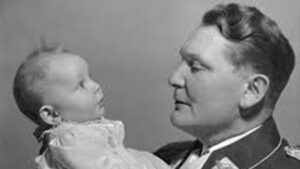 and it was obvious how much he loved me. My only memories of him are loving ones. I can’t see him any other way. I expect almost everyone has a favorable opinion of my father, except maybe in America. He was a good father to me.
and it was obvious how much he loved me. My only memories of him are loving ones. I can’t see him any other way. I expect almost everyone has a favorable opinion of my father, except maybe in America. He was a good father to me.
Edda Göring had received works of art as gifts at her baptism, including “Madonna mit dem Kind” by Lucas Cranach the Elder.  That had been purchased shortly before by the Wallraf-Richartz-Museum for 50,000 Reichsmark. The mayor of Cologne reportedly took it out of the collection. After the war, the city of Cologne challenged the donation with letters dated August 8 and December 7, 1949, arguing that the donation had come about under pressure from Hermann Göring. On 07-03-1962, the Federal Supreme Court ruled that the donation was not made under pressure and did not violate municipal regulations. In 1966 the Bundesgerichtshof ruled that the painting had to be returned to the city of Cologne because both parties had acted in violation of law and morals. Edda Göring tried to get the painting back, but on 23-01-1968, the Oberlandesgericht Köln ruled in favor of the city of Cologne. The painting went back to the Wallraf-Richartz-Museum.
That had been purchased shortly before by the Wallraf-Richartz-Museum for 50,000 Reichsmark. The mayor of Cologne reportedly took it out of the collection. After the war, the city of Cologne challenged the donation with letters dated August 8 and December 7, 1949, arguing that the donation had come about under pressure from Hermann Göring. On 07-03-1962, the Federal Supreme Court ruled that the donation was not made under pressure and did not violate municipal regulations. In 1966 the Bundesgerichtshof ruled that the painting had to be returned to the city of Cologne because both parties had acted in violation of law and morals. Edda Göring tried to get the painting back, but on 23-01-1968, the Oberlandesgericht Köln ruled in favor of the city of Cologne. The painting went back to the Wallraf-Richartz-Museum.
Edda Göring’s ashes are buried in the grave of her mother “Emmy” Sonneman at the München, Waldfriedhof, Neue Teil. Lorettopl. 3, 81377 München. Section 459- Row 1-Grave 322.
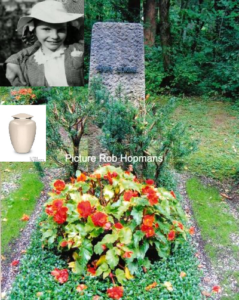
















Leave a Reply